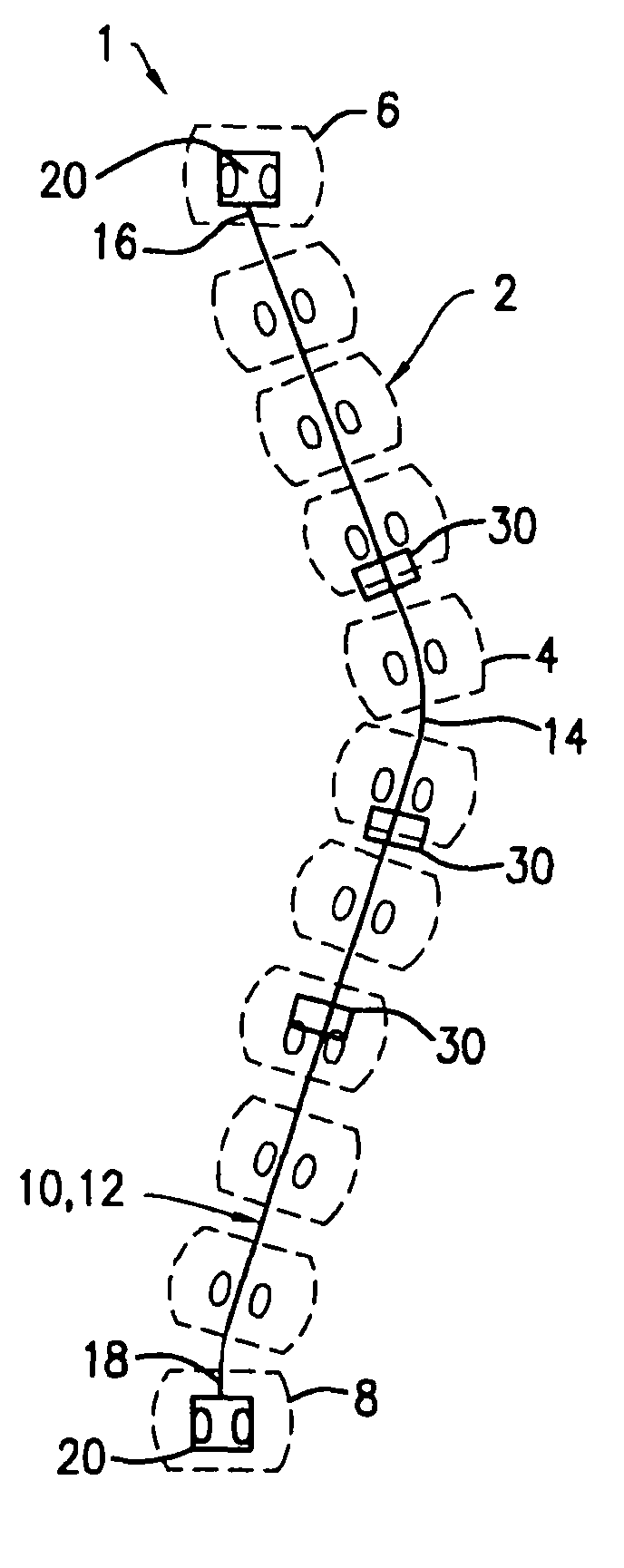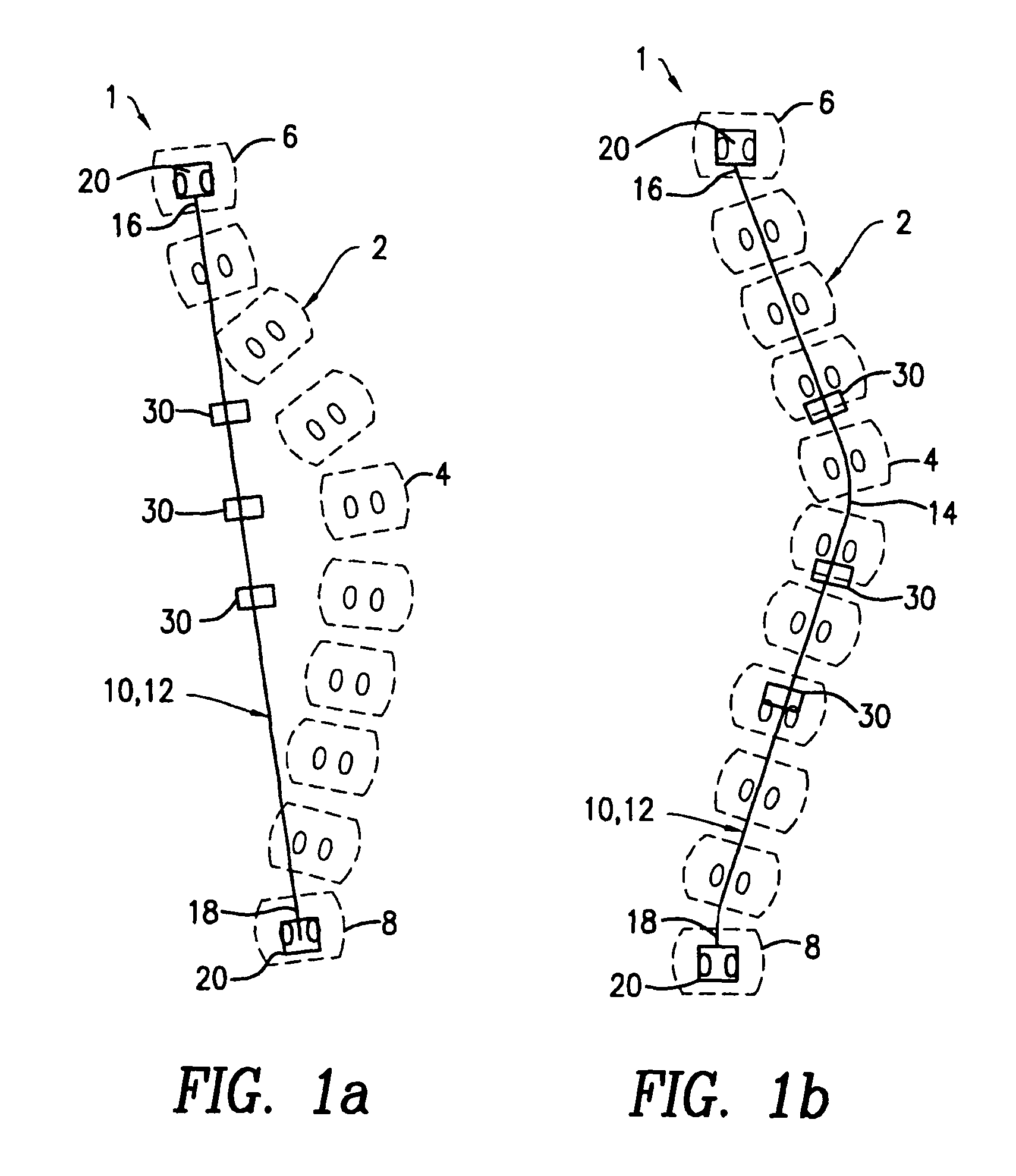Device for correcting spinal deformities
a technology for spinal deformation and devices, applied in the field of devices for and a method of correcting spinal deformation, can solve the problems of limited control of sagittal plane correction of the harrington system, loss of lumbar lordosis, and inability to achieve postoperative external support,
- Summary
- Abstract
- Description
- Claims
- Application Information
AI Technical Summary
Benefits of technology
Problems solved by technology
Method used
Image
Examples
first embodiment
[0045]FIGS. 1a and 1b show the correction device 1 for correcting various spinal deformities, such as scoliosis. The correction device 1 can be in various forms and be mounted onto at least a portion of the spine 2. For example, the correction device 1 can be either applied to the vertebral body anteriorly or applied to elements of the neural arch posteriorly. In one embodiment, the correction device 1 can comprise a support member 10 of various forms. In an exemplary embodiment, the support member 10 can comprise a supporting rod 12 of various shapes. For example, the supporting rod 12 can have a general curved shape, such as a “C” or “S” shape, or other shapes depending on the sagittal profile of the spine. In another exemplary embodiment, the support member 10 can be contoured to conform to the natural spine curvature(s). For example, the support member 10 can be contoured to assume the normal degree of spine kyphosis and / or lordosis. In an exemplary embodiment, such as shown in ...
second embodiment
[0052]FIG. 2 shows the correction device 1, which is of a single support member type. Similar to the above, the support member 10 can be in a “C” or “S” shape, depending on the sagittal profile of the spine. In an exemplary embodiment, the support member 10 can be longitudinally aligned on the posterior side of the vertebrae. In another exemplary embodiment, the support member 10 can be disposed on the deformed spine 2 extending between a proximal vertebra 6 and a distal vertebra 8. The support member 10 can be mounted onto the spine 2 to provide a support for the correction device 1. In an exemplary embodiment, such as shown in FIG. 2, the two ends 16 and 18 of the support member 10 can be fixed to the proximal vertebra 6 and the distal vertebra 8. In another exemplary embodiment, the support member 10 can be secured to multiple sections of the deformed spine 2.
[0053]One or more anchor members 30 can be used to join the support member 10 with the deformed spine portion 4. Similar t...
third embodiment
[0055]FIG. 3 shows the correction device 1, which is of a dual support member type. The correction device 1 can comprise first and second support members 10a and 10b, such as in the form of “C” or “S” shaped supporting rods 12a and 12b. The support members 10a and 10b can be disposed in various positions in relation to the deformed spine 2. In one exemplary embodiment, at least one of the support members 10a and 10b can be longitudinally aligned on the posterior side of the spine 2. In another exemplary embodiment, the first and second support members 10a and 10b can fit into the concave and convex sides of the deformed spine portion 4, respectively. If desired, one or more cross-linking elements 40 can be provided to connect between the support members 10a and 10b, such as shown in FIG. 3.
[0056]The support members 10a and 10b can be secured to the deformed spine 2 in various manners. In one exemplary embodiment, the support members 10a and 10b can extend from a proximal vertebra 6 ...
PUM
 Login to View More
Login to View More Abstract
Description
Claims
Application Information
 Login to View More
Login to View More - R&D
- Intellectual Property
- Life Sciences
- Materials
- Tech Scout
- Unparalleled Data Quality
- Higher Quality Content
- 60% Fewer Hallucinations
Browse by: Latest US Patents, China's latest patents, Technical Efficacy Thesaurus, Application Domain, Technology Topic, Popular Technical Reports.
© 2025 PatSnap. All rights reserved.Legal|Privacy policy|Modern Slavery Act Transparency Statement|Sitemap|About US| Contact US: help@patsnap.com



